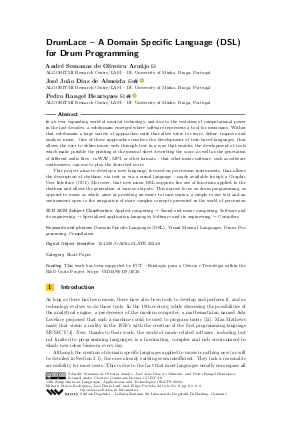DrumLace - A Domain Specific Language (DSL) for Drum Programming (Short Paper)
Authors
André Semanas de Oliveira Araújo,
José João Dias de Almeida  ,
Pedro Rangel Henriques
,
Pedro Rangel Henriques 
-
Part of:
Volume:
13th Symposium on Languages, Applications and Technologies (SLATE 2024)
Part of: Series: Open Access Series in Informatics (OASIcs)
Part of: Conference: Symposium on Languages, Applications and Technologies (SLATE) - License:
 Creative Commons Attribution 4.0 International license
Creative Commons Attribution 4.0 International license
- Publication Date: 2024-11-14
File

PDF
OASIcs.SLATE.2024.8.pdf
- Filesize: 1.34 MB
- 9 pages
Document Identifiers
Subject Classification
ACM Subject Classification
- Applied computing → Sound and music computing
- Software and its engineering → Specialized application languages
- Software and its engineering → Compilers
Keywords
- Domain Specific Languages (DSL)
- Visual Musical Languages
- Drum Programming
- Compilation
Metrics
- Access Statistics
-
Total Accesses (updated on a weekly basis)
0PDF Downloads0Metadata Views
Abstract
In an ever expanding world of musical technology, and due to the evolution of computational power in the last decades, a subdomain emerged where software represents a tool for musicians. Within that subdomain a large variety of approaches exist that allow users to create, define, improve and analyze music. One of these approaches involves the development of text-based languages, that allows the user to define music only through text in a way that enables the development of tools which make possible the printing of the musical sheet describing the score, as well as the generation of different audio files - in WAV, MP3, or other formats - that other music software, such as software synthesizers, can use to play the described score. This project aims to develop a new language, focused on percussion instruments, that allows the description of rhythms, via text or via a visual language - made available trough a Graphic User Interface (GUI). Moreover, that new music DSL supports the use of functions applied to the rhythms and allows the generation of various outputs. This narrow focus on drum programming, as opposed to music as whole, aims at providing an easier to learn syntax, a simple to use tool and an environment open to the integration of more complex concepts presented in the world of percussion.
Cite As Get BibTex
André Semanas de Oliveira Araújo, José João Dias de Almeida, and Pedro Rangel Henriques. DrumLace - A Domain Specific Language (DSL) for Drum Programming (Short Paper). In 13th Symposium on Languages, Applications and Technologies (SLATE 2024). Open Access Series in Informatics (OASIcs), Volume 120, pp. 8:1-8:9, Schloss Dagstuhl – Leibniz-Zentrum für Informatik (2024)
https://doi.org/10.4230/OASIcs.SLATE.2024.8
BibTex
@InProceedings{araujo_et_al:OASIcs.SLATE.2024.8,
author = {Ara\'{u}jo, Andr\'{e} Semanas de Oliveira and de Almeida, Jos\'{e} Jo\~{a}o Dias and Henriques, Pedro Rangel},
title = {{DrumLace - A Domain Specific Language (DSL) for Drum Programming}},
booktitle = {13th Symposium on Languages, Applications and Technologies (SLATE 2024)},
pages = {8:1--8:9},
series = {Open Access Series in Informatics (OASIcs)},
ISBN = {978-3-95977-321-8},
ISSN = {2190-6807},
year = {2024},
volume = {120},
editor = {Rodrigues, M\'{a}rio and Leal, Jos\'{e} Paulo and Portela, Filipe},
publisher = {Schloss Dagstuhl -- Leibniz-Zentrum f{\"u}r Informatik},
address = {Dagstuhl, Germany},
URL = {https://drops.dagstuhl.de/entities/document/10.4230/OASIcs.SLATE.2024.8},
URN = {urn:nbn:de:0030-drops-220797},
doi = {10.4230/OASIcs.SLATE.2024.8},
annote = {Keywords: Domain Specific Languages (DSL), Visual Musical Languages, Drum Programming, Compilation}
}
Author Details
- ALGORITMI Research Centre/LASI - DI, University of Minho, Braga, Portugal
Funding
This work has been supported by FCT – Fundação para a Ciência e Tecnologia within the R&D Units Project Scope: UIDB/00319/2020.
References
-
Sample-based synthesis. https://support.apple.com/pt-pt/guide/logicpro/lgsife418f0c/mac.

-
Guido Gonzato. Making Music with Abc 2 A practical guide to the Abc notation. sourceforge, 2022.

-
Jim Heckroth. A tutorial on midi and wavetable music synthesis. Application Note, CRYSTAL a division of CIRRUS LOGIC, 1998.

-
Max Mathews/Bell Labs. Music, 1957.

-
Vincent J Manzo. Max/MSP/Jitter for music: A practical guide to developing interactive music systems for education and more. Oxford University Press, 2016.

-
Mark Marrington et al. Composing with the digital audio workstation. The singer-songwriter handbook, pages 77-89, 2017.

-
Andreas Möllenkamp. Paradigms of music software development. In Proceedings of the 9th Conference on Interdisciplinary Musicology-CIM14, pages 61-63, 2014.

-
Jan Newmarch and Jan Newmarch. Fluidsynth. Linux Sound Programming, pages 351-353, 2017.

-
Han-Wen Nienhuys-Jan Nieuwenhuizen and H Nienhuys. Lilypond, a system for automated music engraving. In Proceedings of the XIV Colloquium on Musical Informatics (konferenciaanyag), 2003.

-
Anders Reuter. Who let the daws out? the digital in a new generation of the digital audio workstation. Popular Music and Society, 45(2):113-128, 2022.

-
Martin Russ. Sound synthesis and sampling. Routledge, 2012.

-
Ge Wang. A history of programming and music, 2012.

